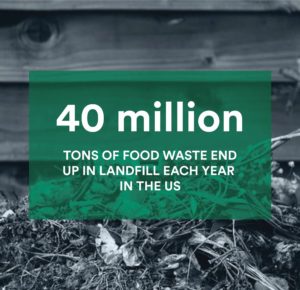While food waste constitutes a troubling 22% of all waste generated in the US, it’s easy to think that because food biodegrades, it’s not as much of a problem as the plastic, metal, and other materials that end up in landfill. The truth is, that food and other organic waste present numerous issues if not dealt with properly.
 As it rots in landfill with other solid waste, discarded food produces methane, a greenhouse gas 25 times more potent than carbon dioxide. In addition to this, it has the potential to create leachate that contaminates groundwater in the local area.
As it rots in landfill with other solid waste, discarded food produces methane, a greenhouse gas 25 times more potent than carbon dioxide. In addition to this, it has the potential to create leachate that contaminates groundwater in the local area.
When you think that 40 million tons of food waste end up in landfill each year in the US, the magnitude of the problem becomes clear. In fact, the EPA estimates that landfill is the third-largest source of human-related methane emissions in the US.
There are also the financial implications of food waste to consider. More than $160 billion of food is wasted every year globally, and in the US, the bill amounts to $1,600 per family on average.
In some countries around the world, food waste at a consumer level is low simply because people can’t afford to waste food. However, in the US and other developed nations, as much as 40% of food purchased at a consumer level ends up in the trash.
So, with food waste a significant issue in both Washington DC and across the nation, what is the capital doing to improve waste diversion and keep organics out of landfill? Here, we explore how the city is helping individuals and businesses strive for sustainability through better food waste management.
 How to deal with food waste in DC
How to deal with food waste in DC
The US capital is seen as a national leader on environmental issues in many ways. For example, there are more green buildings per capita than any other in the US, and in 2017, it achieved Platinum certification in LEED for Cities.
However, when it comes to recycling, the city is falling behind. Despite having introduced a Zero Waste DC policy that aims to divert 80% of trash from landfill by 2032, the current rates for recycling are just 23%, well below the national average of around 35%.
So, what is the city doing to combat food waste specifically? Let’s take a closer look at what is being done, what can be improved, and what you can do to help manage food waste in DC.
Create less waste — The easiest way to tackle food waste in DC

The easiest way to tackle food waste is to reduce the amount you create. Shop more sensibly and be realistic about what you can and can’t use. Each American throws away about a pound of food a day on average, so really think about what you need.
Try and salvage leftovers and get creative in the kitchen. Freeze food when you can, and incorporate peelings and offcuts into soups or to make stock for future meals. You can find plenty of great ideas for how to recycle food scraps and turn them into delicious meals online.
If you can’t use up food, or you find yourself with a surplus, then food donation is the next step on the waste management hierarchy. Around 16% of households in the DC area report struggling to put food on the table. Households with children are more than twice as likely to be food insecure. You can donate food at a number of food banks around the city and foodbank.org has an excellent list to help you find drop-off sites in your area.
Small businesses can also donate excess food without liability thanks to the Good Samaritan Food Donation Act. Of course, not all food is suitable for donation or can be received by voluntary organizations. So, what’s the next step?
How to tackle food waste in DC – Find your nearest compost drop-off
The DC area boasts a number of composting programs that aim to help residents divert food waste away from landfill. One such program in Prince George’s County, Maryland, has pioneered a curbside composting scheme with a large processing facility capable of dealing with more than 50,000 tons of food waste each year.
Additionally, residents in all eight wards can take food scraps and waste to designated farmer’s markets, free of charge. It is then used to make compost and regrow food resources.
Participating markets include:
- Columbia Heights Farmers’ Market
- 14th and Kenyon Streets, NW
- DuPont Circle Farmers’ Market
- 1500 20th Street, NW
- University of District of Columbia Farmers’ Market
- 4340 Connecticut Ave., NW
- Palisades Farmers Market
- 48th Place NW & MacArthur Blvd NW
- Uptown Farmers’ Market
- 14th and Kennedy St., NW
- Brookland Farmers’ Market
- 716 Monroe St., NE
- Eastern Market (in front of Rumsey Pool)
- 635 North Carolina Avenue, SE
- SW Farmers Market
- 425 M Street, SW
- The Arc Farms
- 1901 Mississippi Ave SE
You may need to check whether your chosen market is open, as some close for the season, and what days compost collection is available. In addition, you may need to confirm what is compostable in your chosen market, as some are more selective than others.

Source: washington.org
In its first year, food waste collection grew 400% in the city with around 1,500 households participating in the drop-off program each weekend. However, while this was a good start it represents less than 1% of the 300,000 households in the District. Fortunately, the city is planning on extending these services, and the DC Council has set aside $8 million for constructing a new composting facility in the next year.
To ensure composting becomes a key component of waste diversion, many residents are pushing for curbside collection schemes, such as Prince George’s County scheme, which was able to divert almost 65% of food waste from landfill. The current lack of curbside composting in DC means that residents are left to use community drop-offs or private, charged collection services. All of which means current food recycling rates remain low.
In addition to curbside collection and large-scale composting facilities, DC also needs investment in anaerobic digestion. This is the process by which food is broken down by microorganisms in an environment without oxygen. This kind of digestion is suitable for food scraps, animal waste, fats, and oils and industrial residues. This produces gas which can be used as a fuel source. While not an ideal solution, it is preferable to methane production in landfill.
How to recycle food waste in DC – Curbside services

Source: zerowaste.com
While DC leads the way in some areas, notably sustainable building, it is lagging behind in its recycling and food waste programs. This needs to improve if the city wants to push its sustainability metrics forward.
Surrounding districts have shown what is possible with investment in composting and other means of diverting food and yard waste away from landfill, and DC must begin to implement more robust collection schemes in order to increase diversion.
Today, DC is implementing its zero waste strategy and budgets are in place for increased composting. And for individuals looking to reduce waste and develop sustainable recycling solutions, there are curbside programs they can take advantage of for a fee like Compost Crew that provides weekly food scrap collection services.
For more information on how your business can reduce food waste, or optimize your existing waste management operations, contact our TRUE advisors today. Additionally, subscribe to the RTS blog for more information on sustainable materials, waste reduction, and recycling.

